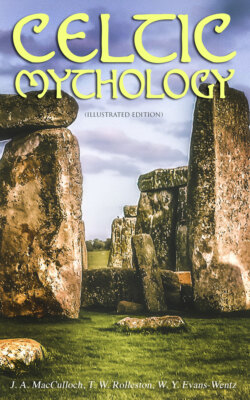Читать книгу CELTIC MYTHOLOGY (Illustrated Edition) - T. W. Rolleston - Страница 88
На сайте Литреса книга снята с продажи.
Festivals
ОглавлениеTable of Contents
The Celtic year was not at first regulated by the solstices and equinoxes, but by some method connected with agriculture or with the seasons. Later, the year was a lunar one, and there is some evidence of attempts at synchronising solar and lunar time. But time was mainly measured by the moon, while in all calculations night preceded day.837 Thus oidhche Samhain was the night preceding Samhain (November 1st), not the following night. The usage survives in our "sennight" and "fortnight." In early times the year had two, possibly three divisions, marking periods in pastoral or agricultural life, but it was afterwards divided into four periods, while the year began with the winter division, opening at Samhain. A twofold, subdivided into a fourfold division is found in Irish texts,838 and may be tabulated as follows:—
| A. Geimredh (winter half) | 1st quarter, Geimredh, beginning with the festival of Samhain, November 1st. |
| 2nd quarter, Earrach, beginning February 1st (sometimes called Oimelc). | |
| B. Samradh (summer half) | 3rd quarter, Samradh, beginning with the festival of Beltane, May 1st (called also Cét-soman or Cét-samain, 1st day of Samono-s; cf. Welsh Cyntefyn). |
| 4th quarter, Foghamar, beginning with the festival of Lugnasadh, August 1st (sometimes called Brontroghain). |
These divisions began with festivals, and clear traces of three of them occur over the whole Celtic area, but the fourth has now been merged in S. Brigit's day. Beltane and Samhain marked the beginning of the two great divisions, and were perhaps at first movable festivals, according as the signs of summer or winter appeared earlier or later. With the adoption of the Roman calendar some of the festivals were displaced, e.g. in Gaul, where the Calends of January took the place of Samhain, the ritual being also transferred.
None of the four festivals is connected with the times of equinox and solstice. This points to the fact that originally the Celtic year was independent of these. But Midsummer day was also observed not only by the Celts, but by most European folk, the ritual resembling that of Beltane. It has been held, and an old tradition in Ireland gives some support to the theory, that under Christian influences the old pagan feast of Beltane was merged in that of S. John Baptist on Midsummer day.839 But, though there are Christian elements in the Midsummer ritual, denoting a desire to bring it under Church influence, the pagan elements in folk-custom are strongly marked, and the festival is deeply rooted in an earlier paganism all over Europe. Without much acquaintance with astronomy, men must have noted the period of the sun's longest course from early times, and it would probably be observed ritually. The festivals of Beltane and Midsummer may have arisen independently, and entered into competition with each other. Or Beltane may have been an early pastoral festival marking the beginning of summer when the herds went out to pasture, and Midsummer a more purely agricultural festival. And since their ritual aspect and purpose as seen in folk-custom are similar, they may eventually have borrowed each from the other. Or they may be later separate fixed dates of an earlier movable summer festival. For our purpose we may here consider them as twin halves of such a festival. Where Midsummer was already observed, the influence of the Roman calendar would confirm that observance. The festivals of the Christian year also affected the older observances. Some of the ritual was transferred to saints' days within the range of the pagan festival days, thus the Samhain ritual is found observed on S. Martin's day. In other cases, holy days took the place of the old festivals—All Saints' and All Souls' that of Samhain, S. Brigit's day that of February 1st, S. John Baptist's day that of Midsummer, Lammas that of Lugnasad, and some attempt was made to hallow, if not to oust, the older ritual.
The Celtic festivals being primarily connected with agricultural and pastoral life, we find in their ritual survivals traces not only of a religious but of a magical view of things, of acts designed to assist the powers of life and growth. The proof of this will be found in a detailed examination of the surviving customs connected with them.
